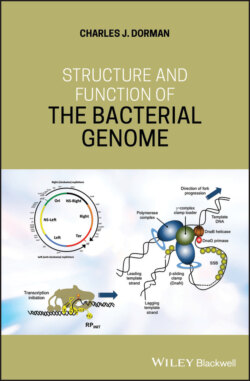Читать книгу Structure and Function of the Bacterial Genome - Charles J. Dorman - Страница 21
1.10 Polar Tethering of Chromosome Origins
ОглавлениеAnchoring the origin of replication to one pole of the cell is likely to assist in reinforcement of the ori‐Ter orientation of the chromosome seen along the long axis of rod shaped cells and in ensuring that daughter cells receive an entire chromosomal copy at cell division (Badrinarayanan et al. 2015) (Figure 1.11). The PopZ protein fulfils this role in C. crescentus by forming a matrix at the pole and interacting with the ParB‐parS complex at oriC (Bowman et al. 2008; Ebersbach et al. 2008). Displacement of parS to a different chromosome site interferes with this arrangement: while parS continues to be located at the pole oriC, from which parS is now disconnected, lies elsewhere in the cell (Umbarger et al. 2011).
The cytoplasmic protein HubP connects the origin of replication of ChrI to the cell pole in V. cholerae. The connection is made between HubP and the ParAI‐ParBI‐parS complex. In addition to its membrane location, the HubP protein is connected to the cell wall through a peptidoglycan‐binding LysM motif, a feature that is required for its polar localisation (Yamaichi et al. 2012).
Polar attachment of the chromosome occurs in B. subtilis at the onset of sporulation. The RacA protein interacts with the DivIVA membrane protein that is located at the cell pole (Ben‐Yehuda et al. 2003; Lenarcic et al. 2009; Oliva et al. 2010; Ramamurthi and Losick 2009; Wu and Errington 2003). RacA also binds to ram (RacA binding motifs) that are found in 25 copies at oriC (Ben‐Yehuda et al. 2005). In the absence of RacA or DivIVA, sporulating bacteria fail to position the chromosome correctly and have the oriC at mid‐cell. This misplacement leads to the production of prespore compartments without chromosomes (Ben‐Yehuda et al. 2003). B. subtilis cells do not have their chromosomes attached to the cell pole during vegetative growth, although their origins occupy positions that alternate between pole‐proximal and at quarter‐cell, arrangements that require the cytoplasmic SMC complex (Wang, X., et al. 2014), just as the MukBEF equivalent in E. coli is required for that organism's chromosome to exhibit its customary ori‐Ter orientation during rapid growth (Danilova et al. 2007).
